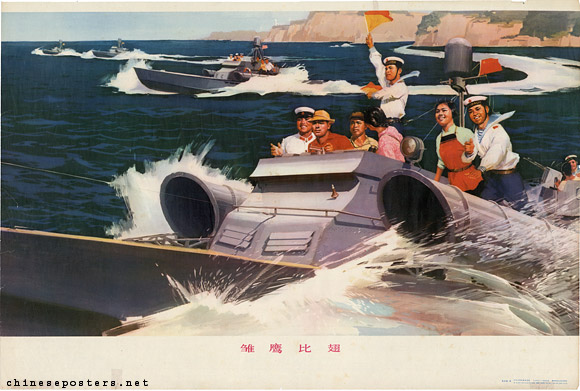Struggle hard, to build up a strong Navy, 1977
The People's Liberation Army Navy (PLAN - 解放军海军) has seen a steady increase in its budget and allocations since 1978, in line with the leadership's desire to reform the force and expand its role. The Navy essentially used to have a limited "white water" capability with coastal defense responsibilities. The plans entailed the development of a "green (or blue) water" capability, increasing the operational range to some 400-600 miles, thereby enabling Chinese power projection in for example the South China Sea. A stronger naval presence here could influence such unsolved problems as Taiwan and the Spratly Islands. The Chinese position in the region had already been strengthened in 1974, when the Paracel (Xisha) Islands were taken over from the Vietnamese.
Battle hymn of the Xisha (Paracel) Islands, 1974
These plans have resulted in the acquisition of, i.a., submarines (Kilo's) from Russia. The growth of PLAN has also been in line with the increased Chinese commercial shipping activities in the region. The greater visiblity of PLAN in regional waters has caught the attention of neighbors such as Japan, which was forced to pay a more active interest in the defense of its sea lanes of communications (SLOC) from 1992 onward.
Manoeuvres on sea, early 1980s
One of the recurring themes in the discussion about PLAN expansion has been the acquisition of aircraft carriers. Until now, China has two such vessels: The Liaoning (辽宁号), the refurbished former Soviet aircraft carrier Varyag (Kuznetsov class); and the Shandong (山东号), completely produced domestically. Adding more aircraft carriers, as the PLAN envisages, alters the strategic balance in the region and causes considerable alarm in Japan and the United States. Operating one or more aircraft carriers would strengthen China's military position vis-à-vis Taiwan and the various contenders for the Spratly Islands, potentially leading to a regional arms race. Other structural PLAN-weaknesses seem to be the number of landing craft, maintenance and logistics.
Young eagles compare wings, 1977
Under the PLA nuclear strategy of "minimal deterrence", PLAN has been successful in developing nuclear-powered submarines and submarine-launched ballistic missiles (SLBM), which it first tested in 1982. Although such missiles can pose a threat to the American West Coast, it is unclear how accurate and reliable they are in the light of a number of commercial rocket launches which were plagued by numerous failures in recent years.
Always be alert, encroaching enemies must be annihilated, 1971
ANG Cheng Guan, "The South China Sea Dispute Revisited", Australian Journal of International Affiars, vol. 54, no. 2 (2000), pp. 201-215
Flemming Christiansen & Shirin Rai, Chinese Politics and Society - An Introduction (London etc.: Prentice Hall 1996)
John Wilson Lewis & Xue Litai, China’s Strategic Seapower - The Politics of Force Modernization in the Nuclear Age ( Stanford: Stanford University Press, 1994)
Andrew J. Nathan & Robert S. Ross, The Great Wall and the Empty Fortress - China’s Search for Security (New York etc.: W.W. Norton & Company 1997)








































